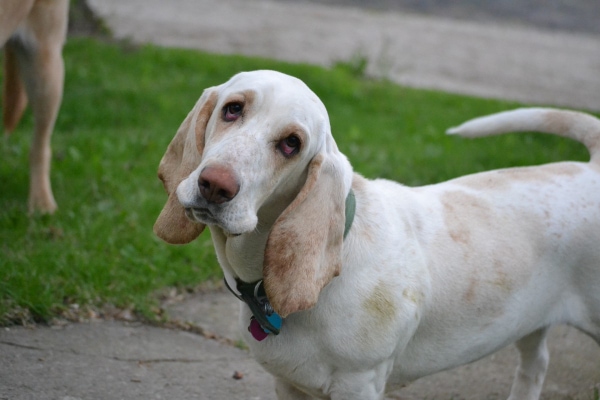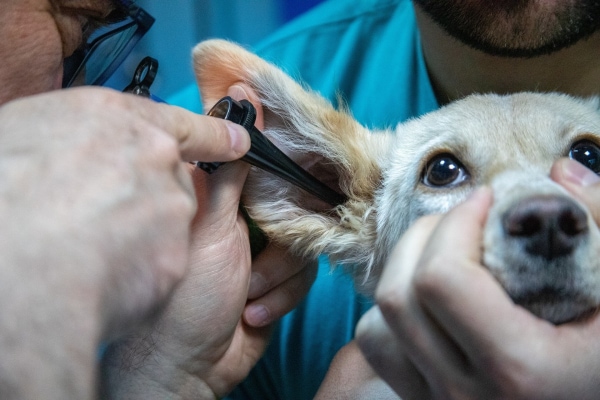Hearing loss in dogs, be it gradual hearing loss or sudden hearing loss, can occur for a variety of reasons. But thankfully, most dogs learn to cope well. To help you navigate your dog’s hearing loss, integrative veterinarian Dr. Julie Buzby explains the signs of hearing loss, why dogs may experience hearing loss, how your vet can assess your dog’s hearing, and how to help and support your deaf dog.

Do you have a senior dog who doesn’t respond to you when you call his or her name? Or one who no longer runs to the door when someone knocks? Sometimes a dog is simply distracted by his or her surroundings or uninterested in leaving his or her cozy bed. However, failure to react to sounds could also indicate an actual problem—the onset of hearing loss in dogs.
Sometimes your dog’s sudden hearing loss may seem to come out of nowhere. Other times, hearing loss may be a more gradual process. But either way, it is helpful to understand how to recognize the signs of hearing loss, what might have caused your dog’s hearing loss, and how you can best help your dear companion.
What is hearing loss in dogs?
Hearing loss in dogs is a decrease in or absence of the ability to perceive sounds. Sometimes dogs may only have partial hearing loss, meaning they can hear some sound but not hear well. Other dogs may be completely unable to hear.
Additionally, hearing problems may impact one or both ears and be temporary or permanent. Sometimes the dog experiences sudden hearing loss and other times it occurs slowly over a period of time. Plus, the age of onset can vary too. Puppies can become deaf shortly after birth or dogs can lose their hearing as adults or seniors.
What are the signs of hearing loss in dogs?
All of these factors can influence the signs of hearing loss you notice. For example, dogs with hearing loss in one ear may compensate well enough with the other ear that you notice very few changes. And dogs who only have partial hearing loss or lose their hearing slowly generally show less dramatic signs than those who suddenly and completely become deaf.
Additionally, deaf dogs who are stressed or who are receiving information from their other senses (i.e. feeling vibrations or seeing someone at the door) may seem like they are responding to a sound when they really aren’t. Or on the flip side, dogs who are experiencing behavior changes from cognitive decline may show some of the symptoms of hearing loss but actually be hearing just fine.
Thus, the signs of hearing problems in dogs are fairly variable. However, some potential symptoms include:
Not responding to sounds
The average adult or senior dog should respond to certain sounds by directing their attention toward the sound. Or they may actively seek out the source of the noise. For example, many dogs will run to the front door when the doorbell rings. Or they might stand at attention and focus when they hear quiet noises coming from a nearby shrub.
However, dogs with hearing loss, especially if it is rapid, may seem to not notice sounds at all. Or they may have a decreased response to sounds. Even if they do notice the sound, it may be harder for them to find its source.
Difficulty with following commands
It might seem like your dog is ignoring you when you call his or her name. Or he or she may suddenly have trouble with typical obedience commands like sit, down, stay, or come, especially if you aren’t also using hand signals.
Sleeping soundly
It can be difficult to wake sleeping deaf dogs, even if you loudly shake their treat bag or call their name. (However, even some hearing dogs don’t wake up well when sleeping soundly.)

Startling easily
Can you imagine not being able to hear someone come up from behind you? That would be quite startling when they touch you or appear seemingly out of nowhere. This same startle response can happen when a dog loses their hearing, and it may result in fear-biting or trying to run away.
Anxiety
Hearing loss in dogs can cause anxiety because it makes it harder for the dog to keep track of what is going on around him or her. A deaf dog may be nervous about new situations or being left alone. And he or she might be more reluctant to explore new environments.
Excessive barking or decreased barking
Some deaf dogs may bark excessively. Other times you might notice an absence of barking or a change in the sound of the bark. This is where knowing your dog well comes in handy. If your dog suddenly stops barking at every little sound, or if your normally quiet dog is now barking like crazy, this is a red flag.
Not moving the ears when listening
Normally, you may notice your dog’s ears pricking toward a sound or moving when he or she is listening to you. But dogs with hearing loss may have a lack of ear movement when you talk to them or if there is a sound in the environment that normally gets their attention.
Confusion or disorientation
Dogs who are having trouble hearing may act like they don’t quite know where they are or what is going on, especially in unfamiliar circumstances or places.
Changes in activity level
Some dogs with hearing loss may become more active than before, while others may be more likely to lie around or sleep the day away.
Excessive vocalization or aggressive play in puppies
Compared to adult dogs, it can be harder to notice clues of hearing loss in young puppies. Most newborn puppies won’t respond as readily to certain sounds because the structures within their ears are still maturing. However, deaf puppies that are older than six weeks may seem more vocal than their littermates. And they may play more aggressively than their siblings or be harder to rouse.
Signs of other problems that lead to hearing loss
Sometimes you might also see symptoms that go along with one of the canine hearing loss causes (more on that soon).
For example, a dog who has an external ear infection may be scratching and shaking his or her head. And he or she might have a foul smelling discharge and redness in the ear canal.
Or a dog with an inner ear infection may also show signs of vestibular disease in dogs because of damage to the vestibular center in the inner ear. These signs include a head tilt, stumbling when walking, or nystagmus (i.e. rapid eye movements).
How does ear anatomy help your dog hear?
To set the foundation for the causes of hearing loss, it is important to understand how the structures in the ear work together to allow the dog to hear. When these structures are abnormal or damaged, hearing problems can ensue.
External ear canal
The J-shaped tubular external ear canal transmits sound waves from the outside world to the tympanic membrane. If it is blocked or narrow, sound waves have trouble getting through.
Tympanic membrane (ear drum)
Sound waves cause the tympanic membrane to vibrate, which in turn moves the three bones of the middle ear. If the ear drum is broken or damaged, it doesn’t vibrate as well, so it is harder for the sound to get across the middle ear.
Inner ear
The cochlea (used for hearing) and the semicircular canals, saccule, and utricle (portions of the dog’s vestibular system) are housed in the inner ear.
Cochlea
Movement of the middle ear bones cause fluid to vibrate within the spiral-shaped cochlea of the inner ear. This bends hair cells, which turn the sound wave into an electrical signal that travels up the auditory nerve to be perceived by the brain as sound. Damage to any components of the cochlea prevents the “sound signal” from being created and sent to the brain.
Vestibular system components (semicircular canals, saccule, and utricle)
When a dog moves, the fluid in three cavities—the semicircular canals, saccule, and utricle—also moves, which bends specialized hair cells. This creates a nerve impulse that travels to the brain to transmit information about the position of the dog’s body in space (i.e. proprioception in dogs).
The vestibular system structures don’t have anything to do with hearing. However, since they are located near the cochlea, and both use hair cells to create a nerve impulse, sometimes conditions that affect hearing also impact structures within the vestibular system. This may lead to hearing loss and balance problems.
What are the causes of hearing loss in dogs?
Now that you understand how a dog hears, it will be easier to discuss the various things that can go wrong with a dog’s hearing. The causes of hearing loss in dogs can be categorized into two types—congenital (i.e. usually genetic and present since birth) or acquired (i.e. occurring sometime after birth).

Causes of congenital hearing loss in puppies
Normally, a puppy can hear sounds as early as two weeks of age. This is usually around the same time the ear canals open. Then by the time the puppy is six to eight weeks old, the structures in the middle and inner ears are fully developed.
However, sometimes puppies can suffer from congenital deafness. Because it typically occurs shortly after birth, this is the most common reason for loss of hearing in young dogs. It comes in two forms—one which is connected to coat and/or eye color, and one that is not.
Deafness in puppies that is connected to coat color or eye color
You may be aware that deafness is sometimes linked to coat color or eye color. More specifically, puppies with mostly white coats (i.e. the absence of pigment) or merle or piebald coat patterns (i.e. those with patches of dilute pigmentation) have an increased risk of being deaf. Additionally, dogs with one blue eye may be deaf on that side. The explanation for this is cochleo-saccular congenital deafness.
As it turns out, the suppression of melanocytes (i.e. pigment cells) necessary to create those colors may also lead to degeneration of one of the cochlea’s layers. Since the cochlea is vital for hearing, anything that damages it leads to deafness. Dogs with cochleo-saccular deafness generally become deaf within one to three weeks of birth and may be deaf in one or both ears.

Deafness in puppies that is independent of coat or eye color
Alternatively, puppies can have congenital deafness which is not related to coat pigmentation and always affects both ears. Neuroepithelial congenital deafness typically occurs due to the loss of hair cells in the cochlea in the first one to three weeks after birth. By the time a neuroepithelial deafness puppy is five weeks old, he or she completely deaf.
Since hair cells are an integral part of a dog’s vestibular system, neuroepithelial deafness can also impact a dog’s sense of balance. This results in stumbling, dizziness, and other vestibular signs.
Congenital deafness that shows up in adulthood
Interestingly enough, while most cases occur in puppies as just described, an adult-onset version of heritable neuroepithelial deafness also exists. Veterinarians have noted it in breeds such as Border Collies and Rhodesian Ridgebacks around three to five years of age.
Which dog breeds are prone to congenital deafness?
Technically, both types of congenital deafness can affect any dog, particularly if one of their parents was deaf or if they have excessive white coat pigmentation. However, the following breeds may be more prone to congenital deafness:
- Australian Cattle Dog
- Beagle
- Boston Terrier
- Bulldogs (English and French)
- Bull Terrier
- Cocker Spaniel
- Collie
- Dachshund
- Dalmatian
- English Setter
- Fox Terrier
- Great Dane
- Jack Russell Terrier
- Old English Sheepdog
- Scottish Terrier
- Shetland Sheepdog
Causes of acquired hearing loss in adult dogs
On the other hand, acquired deafness refers to hearing loss due to outside factors like infection, trauma, obstruction, etc. Typically, acquired hearing loss is more common in adult or senior dogs. It can be broken down into two categories—conduction deafness and sensorineural deafness.
Conduction deafness due to ear canal blockage or damage
As the name might imply, conduction deafness occurs when something keeps sound waves from being properly transmitted to the inner ear.
Substance blocking the dog’s ear canal
For example, the build-up of ear wax or the application of a viscous, long-acting ear drops can lead to temporary hearing loss.

Ear infections
Additionally, dogs with chronic ear infections (i.e. otitis in dogs) may develop conduction deafness over time. This is because the chronic inflammation associated with repeated ear infections leads to permanent changes in the architecture of the dog’s ear canal. In other words, your pup might be dealing with a much smaller ear canal.
Plus, the exudate or debris that accumulates with active infections can physically impede or block sound waves.
Ruptured ear drum
If the ear drum ruptures due to infection or trauma, it cannot transmit sound waves as effectively to the inner ear.
Sensorineural deafness due to inner ear problems
On the other hand, sometimes a dog will be deaf due to problems with the structures of the inner ear, especially the auditory nerve or cochlea. Unlike conduction deafness, which is sometimes reversible (e.g., by the removal of waxy build up from an ear canal), sensorineural deafness is typically irreversible.
Multiple factors can be responsible for the development of sensorineural deafness in dogs including:
Old age
Over time, senior dogs may lose their hearing due to degenerative changes to hair cells and nerve pathways. Late onset age-related hearing loss tends to be the most common cause of acquired deafness in dogs. It is also one of the most common health issues in older dogs. This geriatric-onset hearing loss is also known as presbycusis and tends to occur very gradually.
This means that if your senior canine should suddenly lose his or her ability to hear, it is a good idea to look for other causes of acquired deafness. Sudden hearing loss in dogs can be triggered by most of the factors listed in this category other than old age.
Chronic middle or inner ear infections
If the dog has enough ear infections or particularly severe infections, the inflammation can damage the components of the middle or inner ear. The end result is that your dog is deaf in the affected ear.
Loud noises
Hunting or military dogs who are exposed to gun shots, or other dogs who frequently hear loud noises may lose their hearing over time.
Toxins or medications
Dogs may become deaf due to ototoxicity (i.e. exposure to substances that are toxic to the structures of the ear). For example, some medications used to treat ear infections can occasionally damage the inner or middle ear.
Additionally, hearing loss can occur due to systemic drug toxicity (e.g. chemotherapy, diuretics, salicylates, aminoglycosides).
General anesthesia
In rare cases, general anesthesia can lead to deafness in both ears with an unknown mechanism of action.
Head trauma
If the dog sustains trauma to the bones of the skull surrounding the inner ear, this can cause enough damage to lead to hearing loss. Common causes of head trauma include being hit by a car, falling from a height, being kicked or struck in the head, or being in a dog fight.
Certain pet health conditions
Some systemic conditions such as hypothyroidism in dogs, Cushing’s disease in dogs, and cancer (especially brain tumors in dogs or tumors involving the ear) can cause hearing loss.
Neurologic conditions
Any neurologic issue in dogs (e.g., meningitis, epileptic seizures in dogs, etc.) that affects the central nervous system can lead to problems hearing.
How can you check your dog’s hearing at home?
If you are wondering “Is my dog hard of hearing?” you can start by following the steps below to evaluate your dog’s hearing at home.
- Find a range of types of sounds to use to test your dog’s hearing. Some good options include the doorbell, dropping keys on a hard floor, clapping, whistling, knocking on the door, calling your dog’s name, or rattling the food dish. The key is to have a variety of pitches and levels of loudness.
- Start out by making the sounds close to your dog when he or she is not watching you. Mark down what your dog does for each sound (turns head, runs toward it, moves ears or cocks head, does nothing, etc.). Repeat this on both sides of your dog to see if there is a difference in responses.
- Have someone make the same the sounds in another room while you observe your dog. Write down his or her response.
- Repeat those same sounds when your dog is sleeping and record your observations.
Head to the vet if you suspect hearing loss
Should you have any concerns about your dog’s hearing after performing this at-home hearing test on your dog or based on the symptoms you are seeing, the best thing you can do is make an appointment with your vet. He or she can evaluate your dog’s hearing, examine your dog to see if he or she can determine the cause of the hearing loss, and then formulate a treatment plan.
How will the vet diagnose hearing loss?
Your veterinarian will start by performing a thorough physical examination and asking questions about your dog’s medical history. He or she may ask:
- Is your pup currently taking any medications?
- Has he or she ever had ear infections?
- Can you recall any trauma to the head or ears?
- Has your dog taken any medication recently or undergone anesthesia?
- Was he or she exposed to loud noises?
Then the vet will use an otoscope to get a better look inside both ear canals. Sometimes he or she will see debris, inflammation, foreign material (e.g., hair, grass, or a foxtail in dogs), or even ruptured tympanic membrane. Other times the ear canals will look totally normal.

BAER testing
To confirm your dog has hearing loss, your vet may recommend brainstem auditory evoked response (BAER) testing. This objective hearing test measures the electrical activity in the ear and in the auditory nerve pathways. It can be performed in dogs as young as 35 days of age. Some general practice vets can perform BAER testing, but most of the time veterinary specialists administer this test.
The great thing about BAER testing is that it is non-invasive and does not require sedation. Plus, movements will not affect the test results so it is okay to offer treats to your dog during the test.
To administer the BAER test, the vet will insert small needles on the ends of wires into the skin around the dog’s head and ears. Then the vet will place foam headphones inside the dog’s ear canals. The machine will produce a clicking noise in one ear and white noise in the other to help test one ear at a time. If the sounds don’t generate any electrical activity waves on the readout, this confirms hearing loss in that ear.
Is there a treatment for hearing loss in dogs?
Once the vet or veterinary specialist diagnoses your dog with hearing loss, he or she will discuss the next steps. The underlying cause plays a big role in determining whether the hearing loss is treatable or reversible.
- Congenital deafness—There is no treatment and the deafness is permanent. Dogs who have congenial deafness should not be bred as they can pass it on to their offspring.
- Senensorineural acquired deafness—Most of the time the dog has permanent and irreversible hearing loss. However, while it won’t reverse existing partial hearing loss, using protective ear muffs can help decrease further hearing loss in hunting dogs or military dogs.
- Medications or anesthesia—Sometimes dogs with hearing loss due to general anesthesia or ototoxicity will regain some degree of their hearing over time. Additionally, if the ear canal is simply blocked by a long-acting ear treatment that comes as a viscous medicated gel, hearing often improves again once the body absorbs the drug and any remaining debris is flushed away.
- Ear infections—Treating the ear infection with antibiotics, antifungals, and anti-inflammatories will make the dog more comfortable and resolve the infection. However, it may or may not restore the dog’s hearing depending on how damaged the structures of the ear are.
- Ear canal obstruction (conduction deafness)—Treatment can help reverse hearing loss due to debris, wax, a mass or a foreign body blocking the ear canal. The solution in those cases is simple—remove the thing that is obstructing the ear canal.
- Tumors—Masses in the ear or brain are sometimes treatable with surgery, chemotherapy, or radiation, but the dog’s hearing may or may not come back.
What about hearing aids for dogs?
Sometimes I have clients ask me about hearing aids for dogs. As it turns out, there are a few companies who are working on creating them. However, to date there are no practical or affordable hearing aids for dogs. Also, at this point there are not any cochlear implants for dogs like there are for people. Thus, for many dogs who are experiencing permanent hearing loss, the best thing anyone can do is help them learn to cope with it.

How can you support your dog with hearing loss?
Many dogs with hearing loss will begin to rely on their other senses to help navigate their environment. Also, your body language can provide a lot of information to your furry friend. Hand signals and other visual cues are also a great way to communicate with your deaf dog.
Puppies and adult dogs often learn hand signals for dogs quickly, especially if you use small treats as motivators. However, older dogs with vision loss and hearing loss may have a harder time. Even so, there are still ways to use scent or tactile markers to help deaf and blind dogs navigate their world.
Additionally, consider these approaches to help your deaf dog:
- Walk up to a deaf dog with heavier steps so he or she can feel the vibrations of your footfalls. This helps keep him or her from being startled as easily.
- Consider using a collar that vibrates or buzzes to send a signal to your pup. However, ensure you avoid shock collars as these can cause discomfort and injury.
- Keep your dog with hearing problems on a leash or in a fenced in yard when going outside for bathroom breaks, walks, or playtime. This can help him or her avoid getting into a dangerous situation or getting lost.
- When in public, use a medical alert collar and/or leash with the word “DEAF” printed on them. This helps other people know to be careful not to startle your dog.
What is the quality of life like for dogs with hearing loss?
Often, the tactics we’ve discussed, plus others your vet may suggest, can help your dog adjust to being deaf. Thankfully, many dogs with hearing loss continue to have a good quality of life.
However, occasionally the prognosis is guarded or poor. This is more likely if there is a serious underlying cause present (e.g. cancer) or if the hearing loss significantly impacts your dog’s behavior. Sadly, a deaf dog can occasionally become aggressive or anxious, which can lead to biting or other issues.
Senior dog deafness may be connected to dementia
Additionally, a recent study from North Carolina State University looked at the connection between hearing loss in dogs and canine cognitive dysfunction. Hearing loss is a risk factor for dementia in people. And the study indicated that the same may be true for dogs too.
This link complicates the outlook for senior dogs a bit because the signs of dementia in dogs can sometimes become difficult to manage or negatively impact quality of life. Thus, a senior dog who has hearing loss and dementia may experience more of a decline in quality of life than a dog who only has hearing loss. And a deaf dog may also be more likely to develop cognitive dysfunction as he or she ages.
Hopefully in the future, research will continue to clarify the link between hearing loss and cognitive dysfunction so we can better understand how to help our senior dogs. And maybe in time there will even be functional hearing aids or cochlear implants for dogs. But in the meantime, remind yourself that you and your dog can get through a hearing loss diagnosis.
Hope for dogs with hearing loss
At first, I know it can seem daunting to live with a deaf dog. But believe me—it gets better! There are many resources available to help you and your furry family member adjust. Before you know it, most deaf dogs will settle into the “new normal” and never look back.
Has your dog experienced hearing loss?
Please share your experiences below.
This post was originally published on November 10, 2022 and updated on May 12, 2025.


I’m a sign language interpreter, so I’m fluent in ASL. When I adopted my pup, he was 5 years old with average hearing. I taught him basic commands in sign language (sit, stay, down, go-lay-down, bathroom, eat, ball etc.) because my best friend is Deaf and would occasionally dog sit for us, so I wanted the two of them to be able to communicate. That sweet pup is now 14 years old and moderately-severely deaf. I am SO thankful I taught him ASL so many years ago because he cannot hear my voice any more. But I still use ASL with him to understand his basic needs and to give simple commands. Even if you aren’t fluent in sign language, I’d definitely recommend establishing some type of hand gestures with your verbal commands during training time with your furbabies. That way if they aren’t able to hear your voice anymore, you can still remain connected and have a line of understanding. 🙂
Hi Andrea,
This is amazing! Thank you for sharing your story with us. Wishing you and your sweet senior boy all the best for many happy days ahead.
My Pug went totally deaf several years ago following medication for an ear infection. The side effects listed “deafness, usually temporary.” However, my dog never regained any hearing. There was a caution on the medication that stated not to be used if ear drum was perforated. However, according to our vet, his ear canal was very narrow and she was unable to see his eardrum. Fast forward to just a few months ago and he lost his vision, too, in just a matter of days. Diagnosis: SARDS. No treatment and no cure. He has also adjusted to being blind. However, living in a dark and silent world, he spends most of his days now sleeping. No interest in toys or going for walks anymore. I guess if I couldn’t hear or see, I’d have no interest in playing or going for walks either. On the bright side, he knows where everything is in our home, including his water and food dishes. And he still goes and stands at the door when he needs a potty break.
Dear Sandie,
I am sorry your Pug has endured these hardships. I can only imagine how difficult it is to adjust to life with these sudden changes to his hearing and sight. My best advice is to focus on his sense of smell. See if you can find ways to offer joy and exploration with scents. You could try using a snuffle mat or take him for “walks” in a wagon to allow him to feel the wind and smell his surroundings. Ultimately, the goal is quality of life. As long as he isn’t suffering and still seeks out attention from those he loves, it is ok to continue monitoring his condition and enjoying the time you have together. Praying for comfort and clarity as you navigate this unknown path. Bless you and your sweet boy.
my 14 yr old miniature white schnauzer who has congenital blindness is now going deaf.😪he can hear the sound of a shrill whistle but usually he goes in opposite direction. Any hints?
Hi Patty,
I am sorry your senior pup is struggling with hearing loss while also living with congenital blindness. I apologize for not understanding, but I am uncertain of what sort of hints you are needing. Are you asking about the cause of the hearing loss? Or ways to help your boy navigate his surroundings? The article covers both fairly well, so I am not sure what additional information you are seeking. Feel free to message me back with more details and I will try my best to offer guidance and advice.
I have a 13 year old Chihuahua named Twinkle. Other than being almost totally blind in one eye, she does not have any health issues.
I’m concerned about her hearing. In the past, whenever I called her, she would look right at me. If I was in another room, she would come find me.
For the last few months, when I call out to her, she looks off into another room instead of at me. If she was already looking at me when I spoke, she breaks eye contact and looks around. It is like she’s trying to figure out where my voice or the noise is coming from.
The only change in our environment….. about 6 months ago, I moved from a totally carpeted apartment to one without any carpet.
Is she loosing her hearing or should I get rugs because the echo is confusing her?
Carrie and Twinkle
Hi Carrie,
I understand your concern for Twinkle and think it is good you are searching for answers. Unfortunately, without examining her myself, it is hard to make specific conclusions. Hearing loss is definitely a possibility but I am also suspicious these could be early signs of dementia/canine cognitive dysfunction. I highly recommend you talk to your vet about this new behavior. They may be able to schedule an appointment to assess her hearing. I will also attach links to other articles with more information just in case you wanted to take a look. Hoping you can get the answers you need to ensure your girl remains happy and healthy for as long as possible. Bless you both!
1. Signs of Dementia in Dogs: Stages, Symptoms & Treatment
2. Canine Cognitive Dysfunction in Dogs: Signs, Symptoms, Solutions
Our poodle mix, Kloey, will be 14 in early December. She has had gradual hearing loss over the past year and is now almost completely deaf. Fortunately, she has always been very focused on me, follows me around and I accompanied hand signals with training so now I can used hand signals for come, stop, pointing, etc. since she cannot hear the verbal commands. Her other senses are still strong and we can tell she relies on them more now that she cannot hear. She also relies on our other dogs to let her know when something is going on that she cannot hear. I have also trained them to alert her – such as “go wake sister” or “go get sister”. If I speak loudly directly into her ears she seems to be able to hear a little so I mostly just say her name and positive things and she still responds with a tail wag. She has learned to position herself where we have to walk by her to leave a room or area so that our footstep vibrations wake her or alert her. Her deafness has not seemed to have much of a negative impact on the quality of her life. She still is able to travel with us, play with her toys, and still barks, and is alert and active. It is just part of the aging process for all of us and dogs are so good at adapting and making the best of a situation – we could all learn from them!
Hi Lisa,
Thank you so much for sharing your experience with Kloey’s hearing loss! This is exactly what other readers need to see to find some hope for their similar situations. I love that you incorporated hand signals into Kloey’s training early on and that your other pups play a role in taking care of your sweet girl. She is a very lucky dog. ♥ Best wishes to you all and bless you!
Thank you much for this informative article, My soon to be 16yr old dachshund Willy is experiencing mild hearing loss from age. He can hear me, but he looks around and often goes in the opposite direction indicating he cannot decifer where the sound is coming from. I’m grateful he most definitely still recognizes my voice and does respond to other loud noise, but I have a slight worry for whats to come as he is also just starting to have mild vision loss as well. Other then that, he is in great health, tho the latter ( mild blindness ) has made him a b it tentative with running -something he still does only less frequently. We just had a huge transition also, moving from Chicago to FL and the first week he was very stressed, but I’ve left my perfume around the pathways of the house in hopes it would help and I’m happy to say a week later, he seems to have already adapted. Thank you again and my best wishes for a forever dog for each and everyone out there! Ps: I just had to list my website below, Willy has his own section there of photos if anyone wishes to see him. He’s a beautiful rescue dapple!
Hi Jacqui,
Thank you for sharing your experience with our readers. Willy sounds like such an amazing little pup. I am glad he has adjusted to the new house and is finding joy in his days. Wishing you both the best! ♥
Our beloved German Shepherd Nikki who is 9 y/0 is losing her hearing. She has Systemic Lupus Erythmatous with Polyerosive Arthritis, food and environmental allergies. While she can still hear, we are doing hand and sign language for her to learn.
I will be getting a vibrating collar for her to get her attention when her back is turned away from me.
Hi Teri,
These are great ideas. I love that you are staring early before your girl is completely deaf to give her time to adjust. I am sure she will continue to fight through this setback and have many happy days ahead. Best wishes to you both and give Nikki a hug for me! ♥